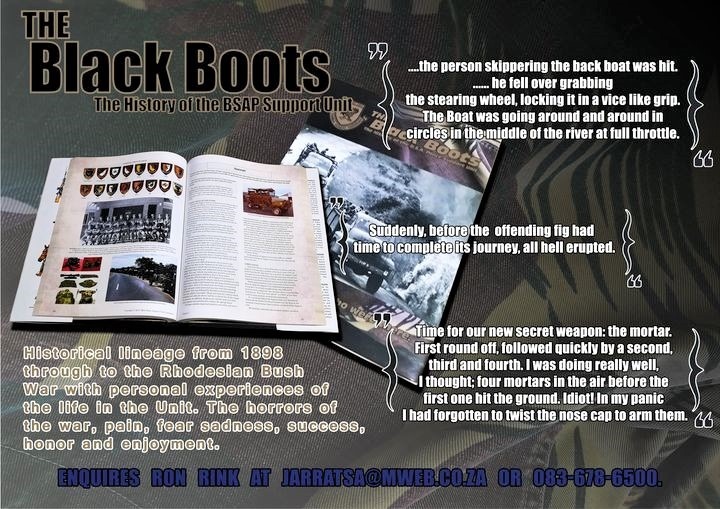
![]()
A TOUR OF DUTY
SUPPORT UNIT, MILITARY WING OF THE BRITISH SOUTH AFRICA POLICE, RHODESIA.
Gerhard van Tonder
By kind permission of the late Barry Woan MLM, former Lance Chief Inspector, Support Unit, British South Africa Police, this article features some of Lance Section Officer Norman Kurz’s combat experiences with this military wing of the BSAP.
These are extracts from the book The Black Boots (BSAP Support Unit Assoc., Ramsgate, South Africa, 2019), compiled by Barry and his team. The end result is a magnificent fully illustrated in colour, history of the Support Unit as told by those who served in this incredibly efficient counter-insurgency combat unit during the Rhodesian war of the 1970s.
Barry himself sustained life-changing injuries on 11 November 1976 when, while commander of Charlie Troop, he was shot in a contact in which, he recounts, “We had been badly shot, including half the call sign along with myself”. Barry was only able to return to duty the following May. With dogged determination and cajoling, and with total disregard for his 20 percent permanent disability that forced him to wear a calliper on one of his legs, Barry returned to active duty as commander of Zulu Alpha Troop.


Norman Kurz recalls the deployment of Juliet Company to Mtoko in 1979
By 1979, Mtoko had a reputation of being a fearsome place to operate. Fire Force and Selous Scouts were based at the JOC [Joint Operations Command], and terrorist incidents were an everyday occurrence. The Muzorewa elections were a few weeks away. It was, therefore, with some trepidation and a sense of anticipation, that I digested the news that Juliet Company’s next bush trip would be to Mtoko.
As I drove the lead Hyena through the gates of the Mtoko JOC in the early afternoon, after a hot and tiring drive from Support Unit Headquarters, I noticed Mike, my company commander, who had travelled ahead of the convoy, in discussion with several individuals outside the radio room. Thinking nothing of it, I stopped the Hyena and proceeded to debus.
The words, “Norman, get your shit together, you’re required on a Fire Force deployment,” snapped me out of my feeling of complacency and sense of general wellbeing.
Bloody hell, WHAT? Support Unit doesn’t do that shit; we’re supposed to call Fire Force, not go with them! I looked at my boss to see if he was serious. The look on his face dispelled the possibility that he was pulling my leg. Fire Force choppers [Alouette III] had arrived before the main elements of RLI [Rhodesian Light Infantry], and additional stop groups were required to respond to a call-out by Selous Scouts [Special Forces].

The South African-produced MRAP (mine resistant and ambush protected) ‘Hyena’ was extensively employed by the Support Unit. (Photo Gerry van Tonder)
And so, with the engine of the Hyena still ticking as it cooled down from the trip, I found myself with three other members of the unit, designated Stop 6, climbing into a chopper, all the time desperately trying to remember the very limited training I had in this regard, and wishing fervently that I had paid more attention at the time.
As the chopper lifted off and gained altitude, I glanced to my left: Constable Edward Chiwetu, cradling the MAG [machine gun] across his knees like a toy, was watching me. A big and powerful man who could fire sustained and accurate bursts from the shoulder while standing. No mean feat. He smiled with a white flash of teeth. I remembered that he had never been in a chopper in his life but had shown absolutely no hesitation when I selected him for this task.
My troop sergeant, Patrick, looked frighteningly calm, leaning out of the chopper, scanning the ground as it flashed by. If I did not know better, I would have assumed that this was just another day in the office for him. Only Cst Moyo looked alarmed; wide eyed and sweating. All three men had been with me since the formation of Juliet Company. I felt a sense of pride and my previously waning confidence returned. It would be OK once we got back on the ground, I told myself. I wiped the sweat from my eyes and began to enjoy the ride as the chopper skimmed the trees beneath us. This would not be a lemon; the contact was already in progress.
After what seemed a short time, the chopper banked sharply to the right. I saw the white smoke marking the contact area and the K-car [helicopter gunship] circling overhead providing top cover, its 20mm canon protruding menacingly from the fuselage.
The chopper suddenly dropped like a stone and I braced for the impact. The noise of the rotors changed abruptly as the pilot expertly feathered the rotors and brought the chopper to a hover a metre or so off the ground. He nodded his head three times and we were out and running, doubled over to avoid the rotors even though we were well clear of them.
The chopper had just cleared the landing zone when the radio on my back came to life as the first instructions came in from the Fire Force commander circling overhead in another chopper. I was struck by the calmness of his voice, which contributed significantly to restoring my own sense of confidence. We quickly formed an extended line and moved forward towards the smoke, Edward on my immediate left, as had become our custom, for I shot left-handed and he shot right-handed. No instructions were required; we had done this many times before.

A Fire Force Alouette III helicopter prepares to drop a four-man combat team into a contact. (Photo Beryl Salt)
The K-car pounded the river line directly in front of us. I checked again to make sure the orange dayglo sewn onto my hat was visible to those above. I saw a Lynx [bespoke Cessna 337G ground-attack aircraft] turn for its run and accelerate in a steep, downward trajectory towards the smoke. A black container detached itself moments before the Lynx pulled up in a near vertical climb. A bit close, I thought.
We scrambled for cover and awaited developments as the afternoon sun sank below the horizon. It would prove to be a long, cold and sleepless night, interrupted periodically by the detonation of RU-deployed claymore mines and sporadic gunfire as ZANLA [insurgent] elements attempted to break through the cordon set around them.
Just before first light there was furtive movement in front of our position and it was our turn to hold the line. Such was our introduction to Mtoko.
Two days later, my Troop, Juliet 3, was deployed to a forward operating base to the east of All Souls Mission. Juliet 1 and 2 were on their way to Mrewa. Juliet 3 was to relieve a detachment of Internal Affairs stationed in the district, who were being withdrawn from the area as the war raged around them. I would be in the unfamiliar role of running the base.
The trip out proved to be uneventful and when I reached the forward operating base I was beginning to wonder what all the fuss was about. In the coming days, I would have reason to reflect upon my naivety. There would be very few occasions in the future that we would travel that same road without incident.
The officer commanding the Internal Affairs detachment met us at the gate, his troops already on vehicles, singing and awaiting the order to move out. The picture he painted was a bleak one and his parting words were to warn me of a probable camp attack in the coming days. Sure, I thought. I don’t think so. I should have paid more attention to the numerous pockmarks on the walls of the buildings.
Mtoko is a starkly beautiful place and the base camp was on slightly elevated ground, surrounded by gomos [hills]. We had just been issued one of the new commando mortars, along with 30 rounds, and been given two minutes of instruction in its use. I positioned it in an already constructed foxhole just outside the radio room, pointing it in the general direction of the highest piece of ground overlooking the base. That done, we went through the routines of establishing base, Sgt Patrick taking the lead. It was dark before we relaxed and later retired to bed.
The first mortar landed directly outside the bedroom window, between the door and the Hyena parked outside, peppering both with shrapnel. Shit, FIRST NIGHT! All hell broke loose as I sprinted to the foxhole, I had so nonchalantly examined a few hours before. It seemed a lot further than I remembered. As I got there, an MAG opened up in a constant and steady stream. Cst Chiwetu had reached the foxhole before me, having crossed open ground to get there. He pointed to the offending gomo and I saw the muzzle flashes, and tracers streaking towards us.
Time for our new secret weapon: the mortar. First round off, followed quickly by a second, a third and then a fourth. I was doing really well, I thought, four mortars in the air before the first one hit the ground. Idiot! In my panic I had forgotten to twist the nose cap to arm them. I still worry about that unexploded ordinance to this day. Following rounds landed in the general area of interest and the incoming fire quickly stopped.
A sweep and follow-up at first light would reveal no casualties, but the section tracker pointed out a mortar crater some distance behind the CT firing positions, with a footprint squarely in the middle of it. Oh, for better timing. Now we knew what we were in for.

Members of Support Unit inspecting the border cordon sanitaire fence from a Hyena.
The upcoming elections influenced and changed the way we operated. We were lucky and, despite several contacts, landmines, an ingenious booby trap that should have accounted for half the troop, and a particularly well-planned but poorly executed ambush which ended very badly for the perpetrators, we had not suffered any significant physical injuries.
The booby trap was of particular concern. While returning to the base from JOC Mtoko one afternoon, we passed the turnoff to All Souls Mission without incident and turned left at the T-junction several hundred metres further on. This particular stretch of road was well known for landmine incidents and there were several craters in the road to be negotiated.
A loud bang startled me witless and my first coherent thought was that somebody had inadvertently discharged his weapon in the back of the Crocodile [armoured personnel carrier] I was driving. As I turned around to berate the individual concerned, the vehicle lurched to the right. We proceeded to debus, still clueless as to what was happening. Walking back down the road I noticed a small crater and a burn mark running to the base of a tree, the branches of which overhung the road. I was aghast and my blood ran cold as I glanced up and saw the three mortar bombs suspended in the tree directly above my head.
The right, front wheel of the Crocodile had detonated an anti-personnel mine, which was hard-wired with cortex fuse to the three mortar bombs suspended above the road. For some inexplicable reason, the cortex had burned off at the base of the tree. Lucky indeed; the Crocodile had been carrying 12 members of Juliet Company, with nothing to protect them from an overhead blast. We later detonated the booby trap, and the magnitude of that explosion and the effect on the surrounding area left me deeply shaken and under no illusion as to what the outcome could have been. This incident added a new dimension to the ever-present threat of landmines. In future, we would sweep all suspect areas on foot, walking ahead of the vehicles. Stress was starting to take its toll.
Our bush trip was duly extended to deal with the elections and it was around this time that I started to pay attention to a particularly large and foreboding gomo, just three Ks or so to the south of our base camp. It was a large and imposing feature, with a huge granite dome and heavy vegetation around the base, all clearly visible through the window of the radio room. Numerous kraals hugged the baseline. It dwarfed other features for miles around.

Support Unit, BSAP, MAG gunner. (Photo Barry Woan)
A day or two later I called Sgt Patrick over.
“OK, let’s go tonight and stay for a couple of days, just to check it out,” I said.
It worried me and I brooded for several evenings as I sat on the sandbags along the fence line, staring intently. One evening Patrick sat beside me as darkness approached.
“We should go there, Ishe,” he said, before getting up to attend to ‘Stand To’. There is something about this gomo which worries me, but no gook would have the balls to hang out so close to our camp, I thought.
I had decided to deploy a section led by Sgt Patrick, with Cst Chiwetu as his MAG gunner. The seven-man patrol left the camp just after midnight, their departure timed to get them into position before first light. I watched as they melted silently into the darkness. A short walk, couple of hours at most, I thought. As I made my way back to the radio room, I realized that this was the first time that the section had deployed without me since the formation of Juliet Company. A vague sense of unease swept over me.
The first shot, followed by several quick bursts, woke me from a fitful slumber. As I reached the radio room, the radio burst into life. Sgt Patrick’s voice came over, strength five: “Contact, contact, Chiwetu is down!” My heart sank as I tried to digest the news. Further sporadic firing dispelled any possibility that this was just a bad dream.

“Contact! Contact!”
First light was not far off. JOC Mtoko was contacted and a casevac requested. Waiting was not an option for me and I made my way to the contact site, taking the Hyena off-road to get there.
As I got to the site and knelt beside Edward, who was conscious and able to talk; JOC Mtoko informed us that a chopper was en route for the casevac. The section medic had already done what was necessary. I knelt on the ground beside Edward as I waited impatiently for the chopper.
“Sorry, Ishe,” he said several times.
Sgt Patrick filled in the details. As the section had approached their chosen OP, they had intercepted several individuals leaving the kraal line. In an attempt to avoid unnecessary civilian casualties, Edward had issued a challenge to what he thought were curfew breakers. I had made the very same mistake myself many months before as an inexperienced section leader serving with Zulu Troop. I was more fortunate. Edward had taken a single round through his abdomen for his troubles.
The chopper came into sight in the distance heading northeast towards the base, and I snatched up the radio to talk it in. The pilot responded immediately, and when the chopper had turned 90 degrees and was headed directly towards us, I gave the instruction to deploy red smoke. There was an army doctor on board and ten minutes later Edward was on his way to hospital. There was, unfortunately, no happy ending to this sad and regrettable day. After initially doing well, septicaemia set in and Edward succumbed to his injury about 10 days later.
Cst Edward Chiwetu was given a military funeral and buried at Warren Hills Cemetery. Juliet Company, at full strength, was in attendance; the first fatality for Juliet 3. As I came to attention next to his grave and saluted, I prayed fervently that it would be the last. I turned away with the haunting notes of the Last Post reverberating in my head. I walked past his grieving family who were huddled, grief stricken, at the head of his grave. I tried in vain to stem the tears welling up in my eyes.
RIP, shamwari [friend], for you were a man, like your father before.



THE RHODESIA DESK
Gerhard van Tonder
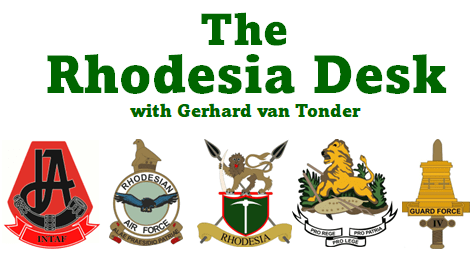

A TOUR OF DUTY
SUPPORT UNIT, MILITARY WING OF THE BRITISH SOUTH AFRICA POLICE, RHODESIA.
Gerhard van Tonder
By kind permission of the late Barry Woan MLM, former Lance Chief Inspector, Support Unit, British South Africa Police, this article features some of Lance Section Officer Norman Kurz’s combat experiences with this military wing of the BSAP.
These are extracts from the book The Black Boots (BSAP Support Unit Assoc., Ramsgate, South Africa, 2019), compiled by Barry and his team. The end result is a magnificent fully illustrated in colour, history of the Support Unit as told by those who served in this incredibly efficient counter-insurgency combat unit during the Rhodesian war of the 1970s.
Barry himself sustained life-changing injuries on 11 November 1976 when, while commander of Charlie Troop, he was shot in a contact in which, he recounts, “We had been badly shot, including half the call sign along with myself”. Barry was only able to return to duty the following May. With dogged determination and cajoling, and with total disregard for his 20 percent permanent disability that forced him to wear a calliper on one of his legs, Barry returned to active duty as commander of Zulu Alpha Troop.
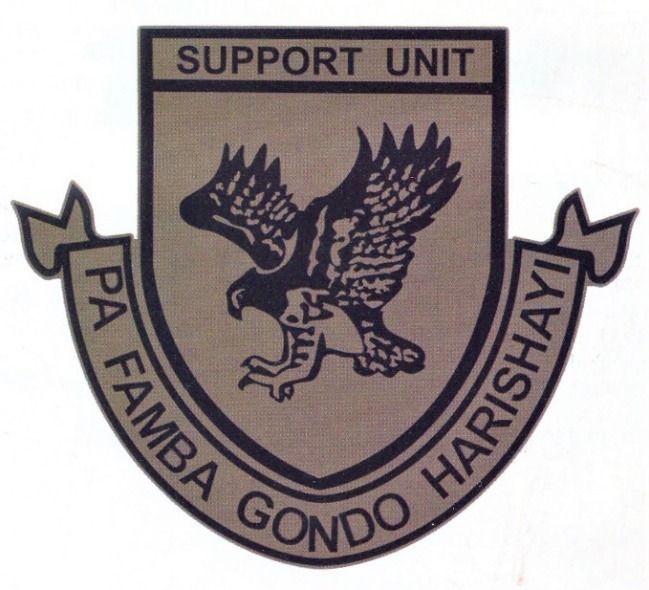
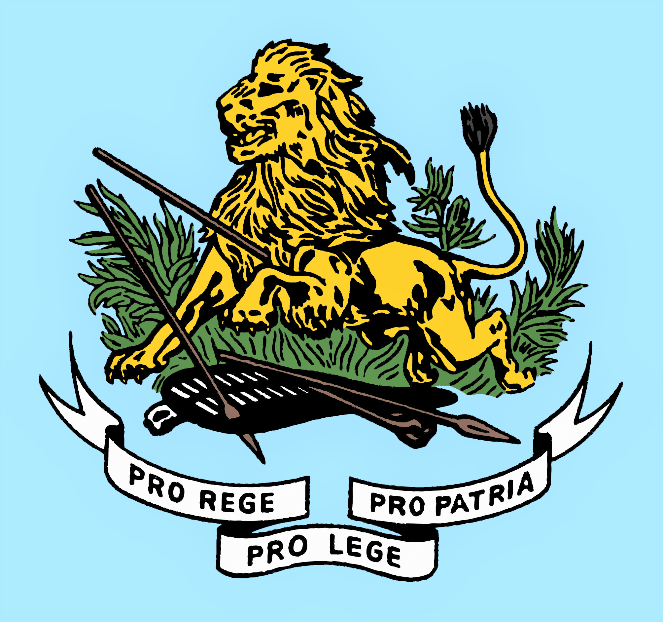
Norman Kurz recalls the deployment of Juliet Company to Mtoko in 1979
By 1979, Mtoko had a reputation of being a fearsome place to operate. Fire Force and Selous Scouts were based at the JOC [Joint Operations Command], and terrorist incidents were an everyday occurrence. The Muzorewa elections were a few weeks away. It was, therefore, with some trepidation and a sense of anticipation, that I digested the news that Juliet Company’s next bush trip would be to Mtoko.
As I drove the lead Hyena through the gates of the Mtoko JOC in the early afternoon, after a hot and tiring drive from Support Unit Headquarters, I noticed Mike, my company commander, who had travelled ahead of the convoy, in discussion with several individuals outside the radio room. Thinking nothing of it, I stopped the Hyena and proceeded to debus.
The words, “Norman, get your shit together, you’re required on a Fire Force deployment,” snapped me out of my feeling of complacency and sense of general wellbeing.
Bloody hell, WHAT? Support Unit doesn’t do that shit; we’re supposed to call Fire Force, not go with them! I looked at my boss to see if he was serious. The look on his face dispelled the possibility that he was pulling my leg. Fire Force choppers [Alouette III] had arrived before the main elements of RLI [Rhodesian Light Infantry], and additional stop groups were required to respond to a call-out by Selous Scouts [Special Forces].

The South African-produced MRAP (mine resistant and ambush protected) ‘Hyena’ was extensively employed by the Support Unit. (Photo Gerry van Tonder)
And so, with the engine of the Hyena still ticking as it cooled down from the trip, I found myself with three other members of the unit, designated Stop 6, climbing into a chopper, all the time desperately trying to remember the very limited training I had in this regard, and wishing fervently that I had paid more attention at the time.
As the chopper lifted off and gained altitude, I glanced to my left: Constable Edward Chiwetu, cradling the MAG [machine gun] across his knees like a toy, was watching me. A big and powerful man who could fire sustained and accurate bursts from the shoulder while standing. No mean feat. He smiled with a white flash of teeth. I remembered that he had never been in a chopper in his life but had shown absolutely no hesitation when I selected him for this task.
My troop sergeant, Patrick, looked frighteningly calm, leaning out of the chopper, scanning the ground as it flashed by. If I did not know better, I would have assumed that this was just another day in the office for him. Only Cst Moyo looked alarmed; wide eyed and sweating. All three men had been with me since the formation of Juliet Company. I felt a sense of pride and my previously waning confidence returned. It would be OK once we got back on the ground, I told myself. I wiped the sweat from my eyes and began to enjoy the ride as the chopper skimmed the trees beneath us. This would not be a lemon; the contact was already in progress.
After what seemed a short time, the chopper banked sharply to the right. I saw the white smoke marking the contact area and the K-car [helicopter gunship] circling overhead providing top cover, its 20mm canon protruding menacingly from the fuselage.
The chopper suddenly dropped like a stone and I braced for the impact. The noise of the rotors changed abruptly as the pilot expertly feathered the rotors and brought the chopper to a hover a metre or so off the ground. He nodded his head three times and we were out and running, doubled over to avoid the rotors even though we were well clear of them.
The chopper had just cleared the landing zone when the radio on my back came to life as the first instructions came in from the Fire Force commander circling overhead in another chopper. I was struck by the calmness of his voice, which contributed significantly to restoring my own sense of confidence. We quickly formed an extended line and moved forward towards the smoke, Edward on my immediate left, as had become our custom, for I shot left-handed and he shot right-handed. No instructions were required; we had done this many times before.

A Fire Force Alouette III helicopter prepares to drop a four-man combat team into a contact. (Photo Beryl Salt)
The K-car pounded the river line directly in front of us. I checked again to make sure the orange dayglo sewn onto my hat was visible to those above. I saw a Lynx [bespoke Cessna 337G ground-attack aircraft] turn for its run and accelerate in a steep, downward trajectory towards the smoke. A black container detached itself moments before the Lynx pulled up in a near vertical climb. A bit close, I thought.
We scrambled for cover and awaited developments as the afternoon sun sank below the horizon. It would prove to be a long, cold and sleepless night, interrupted periodically by the detonation of RU-deployed claymore mines and sporadic gunfire as ZANLA [insurgent] elements attempted to break through the cordon set around them.
Just before first light there was furtive movement in front of our position and it was our turn to hold the line. Such was our introduction to Mtoko.
Two days later, my Troop, Juliet 3, was deployed to a forward operating base to the east of All Souls Mission. Juliet 1 and 2 were on their way to Mrewa. Juliet 3 was to relieve a detachment of Internal Affairs stationed in the district, who were being withdrawn from the area as the war raged around them. I would be in the unfamiliar role of running the base.
The trip out proved to be uneventful and when I reached the forward operating base I was beginning to wonder what all the fuss was about. In the coming days, I would have reason to reflect upon my naivety. There would be very few occasions in the future that we would travel that same road without incident.
The officer commanding the Internal Affairs detachment met us at the gate, his troops already on vehicles, singing and awaiting the order to move out. The picture he painted was a bleak one and his parting words were to warn me of a probable camp attack in the coming days. Sure, I thought. I don’t think so. I should have paid more attention to the numerous pockmarks on the walls of the buildings.
Mtoko is a starkly beautiful place and the base camp was on slightly elevated ground, surrounded by gomos [hills]. We had just been issued one of the new commando mortars, along with 30 rounds, and been given two minutes of instruction in its use. I positioned it in an already constructed foxhole just outside the radio room, pointing it in the general direction of the highest piece of ground overlooking the base. That done, we went through the routines of establishing base, Sgt Patrick taking the lead. It was dark before we relaxed and later retired to bed.
The first mortar landed directly outside the bedroom window, between the door and the Hyena parked outside, peppering both with shrapnel. Shit, FIRST NIGHT! All hell broke loose as I sprinted to the foxhole, I had so nonchalantly examined a few hours before. It seemed a lot further than I remembered. As I got there, an MAG opened up in a constant and steady stream. Cst Chiwetu had reached the foxhole before me, having crossed open ground to get there. He pointed to the offending gomo and I saw the muzzle flashes, and tracers streaking towards us.
Time for our new secret weapon: the mortar. First round off, followed quickly by a second, a third and then a fourth. I was doing really well, I thought, four mortars in the air before the first one hit the ground. Idiot! In my panic I had forgotten to twist the nose cap to arm them. I still worry about that unexploded ordinance to this day. Following rounds landed in the general area of interest and the incoming fire quickly stopped.
A sweep and follow-up at first light would reveal no casualties, but the section tracker pointed out a mortar crater some distance behind the CT firing positions, with a footprint squarely in the middle of it. Oh, for better timing. Now we knew what we were in for.

Members of Support Unit inspecting the border cordon sanitaire fence from a Hyena.
The upcoming elections influenced and changed the way we operated. We were lucky and, despite several contacts, landmines, an ingenious booby trap that should have accounted for half the troop, and a particularly well-planned but poorly executed ambush which ended very badly for the perpetrators, we had not suffered any significant physical injuries.
The booby trap was of particular concern. While returning to the base from JOC Mtoko one afternoon, we passed the turnoff to All Souls Mission without incident and turned left at the T-junction several hundred metres further on. This particular stretch of road was well known for landmine incidents and there were several craters in the road to be negotiated.
A loud bang startled me witless and my first coherent thought was that somebody had inadvertently discharged his weapon in the back of the Crocodile [armoured personnel carrier] I was driving. As I turned around to berate the individual concerned, the vehicle lurched to the right. We proceeded to debus, still clueless as to what was happening. Walking back down the road I noticed a small crater and a burn mark running to the base of a tree, the branches of which overhung the road. I was aghast and my blood ran cold as I glanced up and saw the three mortar bombs suspended in the tree directly above my head.
The right, front wheel of the Crocodile had detonated an anti-personnel mine, which was hard-wired with cortex fuse to the three mortar bombs suspended above the road. For some inexplicable reason, the cortex had burned off at the base of the tree. Lucky indeed; the Crocodile had been carrying 12 members of Juliet Company, with nothing to protect them from an overhead blast. We later detonated the booby trap, and the magnitude of that explosion and the effect on the surrounding area left me deeply shaken and under no illusion as to what the outcome could have been. This incident added a new dimension to the ever-present threat of landmines. In future, we would sweep all suspect areas on foot, walking ahead of the vehicles. Stress was starting to take its toll.
Our bush trip was duly extended to deal with the elections and it was around this time that I started to pay attention to a particularly large and foreboding gomo, just three Ks or so to the south of our base camp. It was a large and imposing feature, with a huge granite dome and heavy vegetation around the base, all clearly visible through the window of the radio room. Numerous kraals hugged the baseline. It dwarfed other features for miles around.
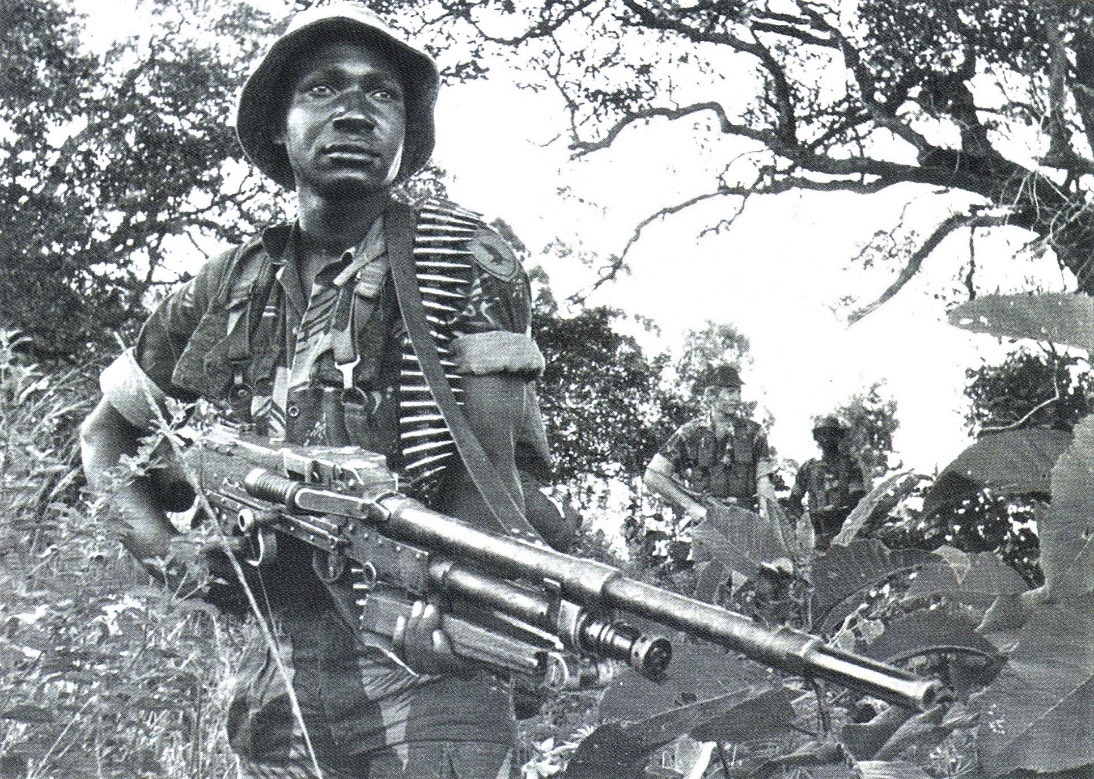
Support Unit, BSAP, MAG gunner. (Photo Barry Woan)
A day or two later I called Sgt Patrick over.
“OK, let’s go tonight and stay for a couple of days, just to check it out,” I said.
It worried me and I brooded for several evenings as I sat on the sandbags along the fence line, staring intently. One evening Patrick sat beside me as darkness approached.
“We should go there, Ishe,” he said, before getting up to attend to ‘Stand To’. There is something about this gomo which worries me, but no gook would have the balls to hang out so close to our camp, I thought.
I had decided to deploy a section led by Sgt Patrick, with Cst Chiwetu as his MAG gunner. The seven-man patrol left the camp just after midnight, their departure timed to get them into position before first light. I watched as they melted silently into the darkness. A short walk, couple of hours at most, I thought. As I made my way back to the radio room, I realized that this was the first time that the section had deployed without me since the formation of Juliet Company. A vague sense of unease swept over me.
The first shot, followed by several quick bursts, woke me from a fitful slumber. As I reached the radio room, the radio burst into life. Sgt Patrick’s voice came over, strength five: “Contact, contact, Chiwetu is down!” My heart sank as I tried to digest the news. Further sporadic firing dispelled any possibility that this was just a bad dream.
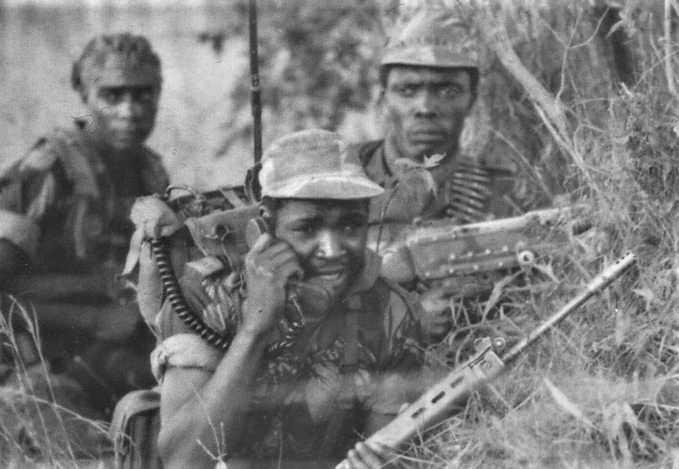
“Contact! Contact!”
First light was not far off. JOC Mtoko was contacted and a casevac requested. Waiting was not an option for me and I made my way to the contact site, taking the Hyena off-road to get there.
As I got to the site and knelt beside Edward, who was conscious and able to talk; JOC Mtoko informed us that a chopper was en route for the casevac. The section medic had already done what was necessary. I knelt on the ground beside Edward as I waited impatiently for the chopper.
“Sorry, Ishe,” he said several times.
Sgt Patrick filled in the details. As the section had approached their chosen OP, they had intercepted several individuals leaving the kraal line. In an attempt to avoid unnecessary civilian casualties, Edward had issued a challenge to what he thought were curfew breakers. I had made the very same mistake myself many months before as an inexperienced section leader serving with Zulu Troop. I was more fortunate. Edward had taken a single round through his abdomen for his troubles.
The chopper came into sight in the distance heading northeast towards the base, and I snatched up the radio to talk it in. The pilot responded immediately, and when the chopper had turned 90 degrees and was headed directly towards us, I gave the instruction to deploy red smoke. There was an army doctor on board and ten minutes later Edward was on his way to hospital. There was, unfortunately, no happy ending to this sad and regrettable day. After initially doing well, septicaemia set in and Edward succumbed to his injury about 10 days later.
Cst Edward Chiwetu was given a military funeral and buried at Warren Hills Cemetery. Juliet Company, at full strength, was in attendance; the first fatality for Juliet 3. As I came to attention next to his grave and saluted, I prayed fervently that it would be the last. I turned away with the haunting notes of the Last Post reverberating in my head. I walked past his grieving family who were huddled, grief stricken, at the head of his grave. I tried in vain to stem the tears welling up in my eyes.
RIP, shamwari [friend], for you were a man, like your father before.
